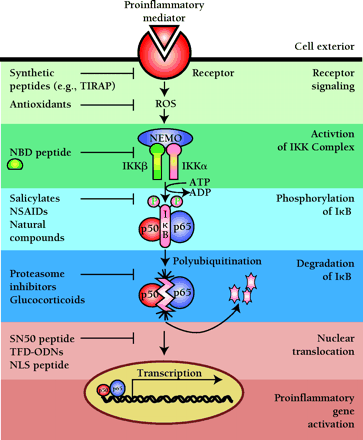
- Institution: Stanford Univ Med Ctr Lane Med Lib/Periodical Dept/Rm L109
- Sign In as Member / Individual
Inhibition of Nuclear Factor Kappa B (NF-B):

A variety of drugs that inhibit NF-κB have been classified according to their molecular targets. Several intermediate steps (denoted at right) in proinflammatory signal transduction pathways can be targeted by inhibitors of NF-κB (indicated on left). The dimeric nature of NF-κB, consisting of 50-kDa and 65-kDa subunits, is indicated by two circles. Synthetic, cell-penetrating peptides, such as those derived from TIRAP (Toll-interleukin 1 receptor domain-containing adapter protein), the NEMO-binding domain (NMD) of the IKKβ protein, the nuclear localization signal of the p50 subunit of NF-κB (SN50), and other nuclear localization signals (NLSs), are discussed in the text. (Other abbreviations: ROS, reactive oxygen species; NEMO, NF-κB essential modulator; IKK, IκB kinase; IκB, inhibitor of NF-κB; TFD-ODNs, transcription factor decoy oligodeoxynucleotides.)


